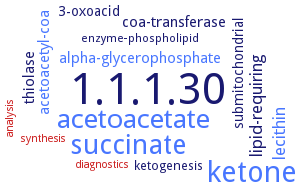Please wait a moment until all data is loaded. This message will disappear when all data is loaded.
Please wait a moment until the data is sorted. This message will disappear when the data is sorted.
(DL)-2-hydroxybutyrate
-
5 mM, pH 8.5, 25°, 69% inhibition
(DL)-lactate
-
5 mM, pH 8.5, 25°C, 65% inhibition
2,4-Dichlorophenoxyacetic acid
-
inhibits the enzyme, in vivo treatment of the animals with 2,4-dichlorophenoxyacetic acid leads to strong decrease of triglycerides level and HDL cholesterol and an increase in GOT level and LDL cholesterol, and necrosis of seminiferous tubules cells in testis, hyperplasia of hepatocytes in liver and presence of multinucleated giant cells in brain, overview
2-Hydroxybutyrate
-
10 mM, 57% inhibition
2-oxobutyrate
-
10 mM, 29% inhibition
3-hydroxybutyrate
-
substrate inhibition at concentrations above 20 mM, 50% inhibition at 200 mM, cyanylated enzyme is 3fold more active at high substrate concentration
4-mercapto-3-nitrobenzoate
-
derivatization of enzyme sulfhydryl groups, less than 1% residual activity
5,5'-dithiobis(2-nitrobenzoic acid)
-
0.15 mM, 63% inhibition
acetoacetyl-CoA
-
1 mM, 29% inhibition
acetyl-CoA
-
1 mM, 82% inhibition
acetylphosphonate
-
16.7 mM, pH 7, 28% inhibition
ADP
-
2.85 mM, 0.025 mM NADH, 63% inhibition, competitive inhibitor vs. NADH and NAD+, pH 7-7.5, noncompetitive vs. acetoacetate
ADP-ribose
-
competitive inhibition vs. coenzyme, noncompetitive vs. substrate
AMP
-
2.85 mM, 0.025 mM NADH, 55% inhibition, competitive inhibitor vs. NADH and NAD+, pH 7-7.5
ATP
-
2.85 mM, 0.025 mM NADH, 79% inhibition, competitive inhibitor vs. NADH and NAD+, pH 7-7.5, noncompetitive vs. acetoacetate
crotonate
-
10 mM, 20% inhibition
CuSO4
-
1 mM, 81% inhibition
D-lactate
-
5 mM, pH 8.5, 25°, 85% inhibition, uncompetitive vs. coenzyme, competitive vs. substrate
diazenedicarboxylic acid bis(dimethylamide)
dimethyl phosphate
-
16.7 mM, pH 7, 12% inhibition
dimethyloxyphosphinylacetate
-
competitive inhibitor vs. acetoacetate
EDTA
inhibition and destabilization of the enzyme at 10 mM
glucose
inhibits the enzyme when contained in the growth medium
Hg2+
inhibition at 1 mM, and destabilization at 10 mM
KCl
-
80-100 mM, 50% inhibition
LiCl
-
80-100 mM, 50% inhibition
methanephosphonic acid
-
3.3 mM, pH 7, 11% inhibition
methyl methylphosphonate
-
3.3 mM, pH 7, 13% inhibition
methyl phosphate
-
16.7 mM, pH 7, 21% inhibition
Methyl-2-methoxyphosphinylacetate
-
competitive inhibitor vs. acetoacetate
MnCl2
-
1 mM, 50% inhibition
NaCl
-
80-100 mM, 50% inhibition
NAD+
-
substrate inhibition, high concentrations, noncompetitive vs. beta-hydroxybutyrate
NH4Cl
-
80-100 mM, 50% inhibition
oxalate
-
16.7 mM, pH 7, 9% inhibition
Phenylarsine oxide
-
NAD+ and NADH protect against inhibition
propionate
-
5 mM, pH 8.5, 25°C, 9% inhibition
sodium acetonylphosphonate
-
3.3 mM, pH 7, 21% inhibition
sodium monomethyl acetylphosphonate
-
16.7 mM, pH 7, 60% inhibition
sodium monomethylacetonylphosphate
-
16.7 mM, pH 7, 30% inhibition
Sodium sulfide
-
competitive vs. beta-hydroxybutyrate
sodium sulfite
-
uncompetitive vs. NAD+ and acetoacetate, competitive vs. beta-hydroxybutyrate
succinate
-
10 mM, 12% inhibition
Zn2+
inhibition and destabilization of the enzyme at 10 mM
acetoacetate

-
substrate inhibition, above 5 mM, noncompetitive vs. NADH
acetoacetate
-
inhibition above 1 mM, 2 mM, 89% inhibition
bromomalonate

-
-
Butyrate

-
5 mM, pH 8.5, 25°C, 22% inhibition
Butyrate
-
10 mM, 20% inhibition
chloromalonate

-
-
diazenedicarboxylic acid bis(dimethylamide)

-
0.20 mM, activity can be recovered with dithiothreitol, enzyme contains a vicinal dithiol that is oxidized by diamide
diazenedicarboxylic acid bis(dimethylamide)
-
NAD+ protects against inhibition
dimethylmalonate

-
15.3 mM, 50% inhibition, oxidation, 11.3% reduction
dimethylmalonate
-
7.6 mM, 50% inhibition, oxidation, 8.5 mM, reduction
HgCl2

-
enzyme extremely sensitive, NADH and Ca2+ protect
HgCl2
-
0.1 mM, 100% inhibition
Hydroxymalonate

-
4.8 mM, 50% inhibition, oxidation, 7.8 reduction
Hydroxymalonate
-
1.8 mM, 50% inhibition, oxidation, 6.0 mM, reduction
L-3-hydroxybutyrate

-
5 mM, pH 8.5, 25°C, 23% inhibition; 5 mM, pH 8.5, 25°C, 32% inhibition
L-3-hydroxybutyrate
is a competitive inhibitor
L-3-hydroxybutyrate
-
5 mM, 73% inhibition
malonate

-
malonate
-
9.5 mM, 50% inhibition, oxidation, 8.2 mM
malonate
-
3.7 mM, 50% inhibition, oxidation
malonate
-
10 mM, 66% inhibition, oxidation
mesoxalate

-
-
methylmalonate

-
methylmalonate
-
2.1 mM, 50% inhibition, oxidation
methylmalonate
-
1.4 mM, 50% inhibition, oxidation, 0.8 mM reduction
methylmalonate
-
brain 3-hydroxybutyrate dehydrogenase, 0.5 mM 69% inhibition, 0.75 mM 83%, 1 mM 87%, 1.5 mM 3-hydroxybutyrate, liver 3-hydroxybutyrate dehydrogenase, 0.1 mM 37% inhibition, 0.25 mM 41%, 0.5 mM 45%, 1 mM 3-hydroxybutyrate, competitive inhibition
N-ethylmaleimide

-
irreversible inhibition
N-ethylmaleimide
-
NAD+ protects against inhibition
NADH

-
competitive vs. NAD+
NADH
-
substrate inhibition, above 0.1 mM, competitive vs. acetoacetate
NADH
-
0.15 mM, 48% inhibition
p-chloromercuribenzoate

-
0.001 mM, extremely rapid inhibition, NAD+ and NADH protect against inhibition
p-chloromercuribenzoate
-
enzyme extremely sensitive, NADH and Ca2+ protect
p-chloromercuribenzoate
-
0.1 mM, 100% inhibition
Phenylglyoxal

-
extremely rapid inhibition
pyruvate

-
16.7 mM, pH 7.0, 22% inhibition
pyruvate
-
4 mM, 5% inhibition




 results (
results ( results (
results ( top
top






